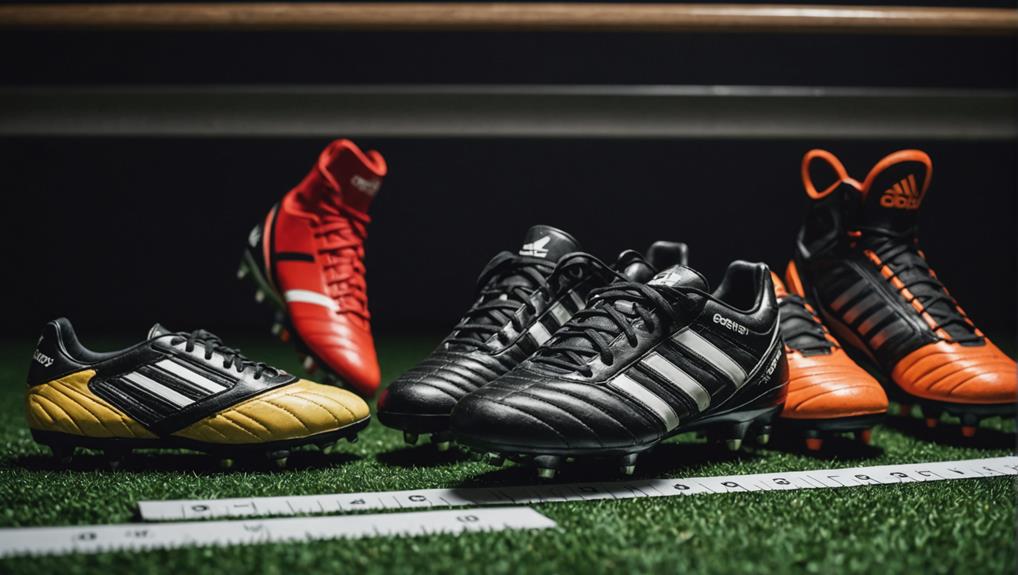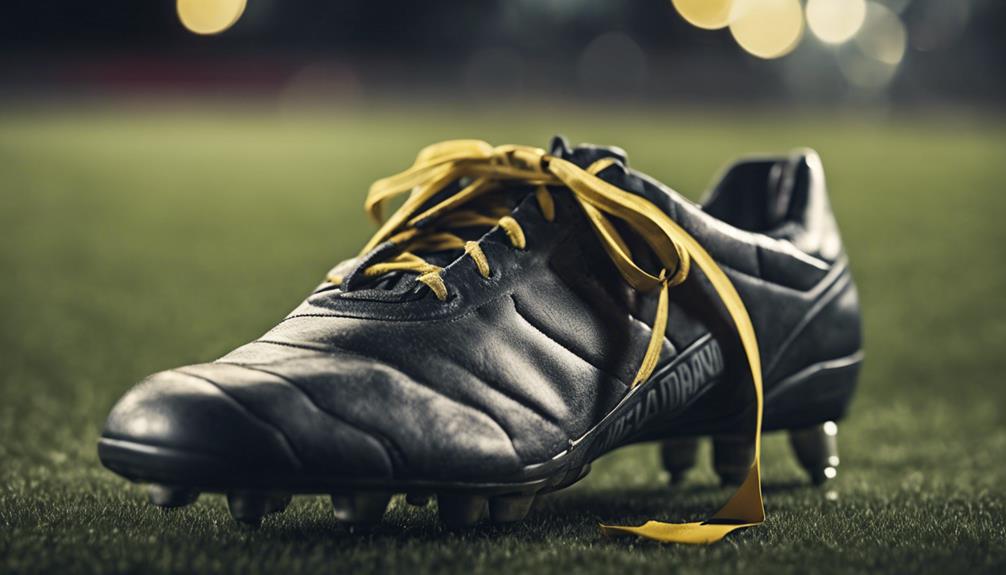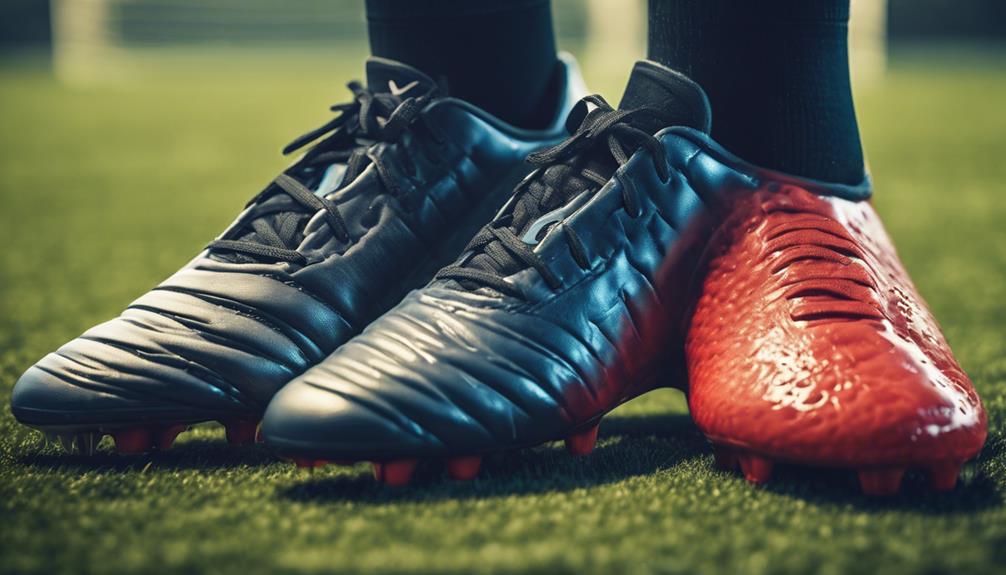
Do Soccer Cleats Run Small? Sizing Tips
August 21, 2024Soccer cleats generally run true to regular shoe size, but it's important to take into account your fit. If you're between sizes or have wider feet, sizing up might provide a more comfortable feel. Making sure your cleats fit snugly is essential to prevent sliding or potential injuries while playing. Remember that different brands and materials can impact fit, so experimenting with sizes and checking specific sizing charts can help you find the ideal pair. Ensuring the right fit guarantees both comfort and performance on the field.
Sizing Soccer Cleats Correctly
When sizing soccer cleats correctly, it's recommended to try on different sizes to secure the best fit for your feet. Soccer cleats generally run true to regular shoe size, but there can be variations among brands, so finding the right fit is essential.
To make sure you have a comfortable fit, consider sizing up if you're in between sizes or have wider feet. It's crucial for properly fitting soccer cleats to feel snug without causing discomfort or cutting off circulation. Checking specific sizing guides provided by brands can also help determine the best size for your feet.
Remember that a snug fit is important to prevent any sliding or injuries while playing. Take the time to find the perfect size that offers both comfort and support for your feet during those intense matches.
Nike Cleats Fitting Guide
To achieve peak efficiency and comfort on the field, understanding the Nike Cleats Fitting Guide is crucial. When it comes to Nike soccer cleats, they generally fit true to your regular shoe size. However, some players prefer a snug fit to enhance ball control.
Nike offers various cleat models like Mercurial Vapor, Phantom, and Tiempo, each tailored to specific player preferences and performance requirements. For the right fit, your Nike cleats should have no heel movement and about a thumb's width of space at the toe for both comfort and best performance.
Crafted from supple synthetic materials, Nike cleats deliver a supportive fit that allows for natural foot movement. It's recommended to try on different sizes and styles of Nike cleats to find the perfect match for your foot shape and playing style.
Choosing the Right Cleat Size

When choosing the right cleat size, make sure you find the ideal fit for peak performance.
Consider the fitting considerations like sizing up for a snug feel if you fall between sizes.
Make sure to check the accuracy of the sizing by consulting brand-specific charts for the best match.
Ideal Cleat Size
For top performance and comfort on the field, selecting the correct cleat size is essential in enhancing your game. When it comes to soccer cleats, finding the perfect cleat size is pivotal for your overall fit and performance. Best-fitting cleat size not only guarantees comfort but also helps prevent blisters and reduces the risk of injuries during play.
To determine the appropriate cleat size, consider trying on different sizes to find the ideal fit for your feet. Keep in mind that snug-fitting cleats can provide better control, agility, and overall performance on the field. Additionally, it's advisable to size up for the larger foot or if you prefer a slightly looser fit for added comfort during matches.
A properly fitting cleat should have minimal movement inside, with approximately a thumb's width of space at the toe. This space allows for optimal comfort and performance while ensuring that your feet are secure in the cleats during gameplay.
Fitting Considerations
Consider the snugness of the fit when selecting the appropriate cleat size for optimal performance on the field. Soccer cleats are designed to match regular shoe sizes accurately, but it's crucial to keep in mind that different brands may vary slightly in their sizing.
To make sure you find the ideal fit, experiment with various sizes and brands, emphasizing a snug sensation with minimal shifting. This will aid in preventing blisters and injuries while playing, particularly on solid ground.
When deciding on your cleat size, consider the kind of socks you intend to wear during matches. A properly sized cleat should leave approximately a thumb's width of room at the toe while also guaranteeing there's no heel movement.
Sizing Accuracy
To make sure you select the right cleat size for peak performance, focus on the accuracy of sizing in relation to your regular shoe size. Soccer cleats typically match your standard shoe size, but it's vital to try on different sizes to find the best fit.
If one foot is slightly larger than the other, think about sizing up to accommodate the larger foot for the best comfort and performance. Proper sizing not only guarantees comfort but also helps prevent injuries on the field.
When it comes to specific brands, Nike Soccer Cleats and adidas® soccer cleats generally stick closely to standard sizing. However, PUMA tends to run slightly smaller, so you may want to think about going up half a size when purchasing PUMA cleats.
Keep in mind that variations in sizing can happen between different models within each brand, so trying them on before buying is important.
Cleats Material Impact on Fit
Leather cleats naturally mold to your feet over time, providing a personalized fit as you wear them in.
Kangaroo leather cleats are known for their pliability and comfort, offering a snug fit that adapts to your foot shape.
On the other hand, synthetic cleats have minimal stretch, so it's important to make sure they fit snugly from the start.
Cleat Material Influence
When selecting soccer cleats, the material of the cleat significantly impacts how they fit on your feet. Here are some key points to take into account:
- Leather Cleats: Leather cleats, like the Tiempo Legend, have a natural stretch that molds to your foot over time, providing a personalized and comfortable fit.
- Synthetic Cleats: Synthetic cleats, such as the Nike Mercurial, offer less stretch compared to leather options. It's important to secure a snug fit from the start to prevent any sliding or discomfort during gameplay.
Understanding the characteristics of different cleat materials will assist you in making an informed decision when choosing the ideal pair for your playing style and comfort preferences.
Fit and Material Interaction
Understanding how the material of soccer cleats interacts with the fit is essential for peak performance on the field. When trying on new cleats, pay attention to how the material feels against your foot.
Leather cleats, known for their ability to stretch and mold over time, can provide a custom fit that feels as close to a second skin. On the other hand, synthetic cleats, which offer less stretch, tend to maintain their shape well, ensuring a snug fit for top performance on the Ground Soccer.
If you prefer a balance between pliability and durability, kangaroo leather cleats could be a good choice, although be aware of any shipping restrictions that may apply. To prevent issues like blisters or discomfort, make sure that synthetic cleats fit as close to your foot as possible, as they may run wide if not fitted properly.
Selecting the right material based on your preferences and playing style can greatly impact your overall comfort and performance on the field.
Material Impact on Fit
Consider how the material of soccer cleats directly influences how well they conform to your foot for best fit and performance. When choosing between synthetic cleats, leather cleats, or Kangaroo leather options, keep in mind the following:
- Leather cleats tend to stretch with wear, providing a more customized fit over time.
- Synthetic cleats offer less stretch and may require a snug fit from the start for peak performance.
The material of the cleats plays an essential role in how they fit and mold to your foot. Leather cleats may offer a more personalized fit as they stretch with use, while synthetic cleats require a precise fit from the beginning. Kangaroo leather, although pliable, may have limitations on availability depending on your location. Selecting the right material is vital for ensuring a comfortable and performance-enhancing fit for your soccer cleats.
Brand-Specific Sizing Tips

For brand-specific sizing tips on soccer cleats, pay attention to how Adidas, Nike, and PUMA sizes may differ based on their unique characteristics. When looking for the right fit, consider that Adidas cleats tend to run wide, so if you have narrow feet, sizing down might be beneficial.
Nike has shifted to unisex sizing, which could impact your usual size choice, so it's wise to double-check before purchasing. On the other hand, PUMA cleats typically run true to size, making it easier to stick to your regular size when buying.
Remember that different brands, and even various models within the same brand, can have varying fits, so always consult brand-specific sizing charts for accuracy. Additionally, reading customer reviews can provide valuable insights into how specific cleats fit, helping you determine if they run small or large.
When it comes to finding the perfect soccer cleat, ensuring the right fit is essential for comfort and performance.
Handling Incorrect Cleat Sizes
If your soccer cleats don't fit properly, address the issue promptly to secure maximum comfort and performance on the field.
When dealing with an incorrectly sized pair of soccer shoes, here's what you should do:
- Consider Exchange: If your soccer shoes tend to run tight, consider exchanging them for a larger size to secure a better fit.
- Check Sizing Charts: Always consult the brand-specific sizing charts to make sure you're selecting the correct size for your feet.
Conclusion
When it comes to soccer cleats, getting the right size is key for best performance on the field. Remember to always refer to brand-specific sizing guides and consider the material of the cleats for the most suitable fit.
For example, a player who chose cleats that were too small experienced discomfort and blisters, affecting their game.
Don't let poorly-fitting cleats hold you back – find the perfect size for your game!


